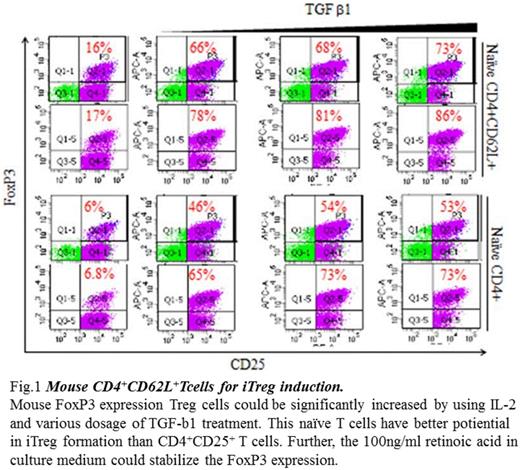Abstract
Allogeneic hematopoietic stem cell transplantation (HSCT) has been used to treat some of hematological malignancies and inherited or acquired non-malignant disorders. Unfortunately, graft-versus-host disease (GVHD) occurred approximately 15% in transplant recipients and impacts on the outcome of allogeneic HSCT. At present, no effective modality could completely prevent the GVHD from allogeneic HSCT patients. CD4+ CD25+ FoxP3+ regulatory T cells (Tregs) have been shown to be important in maintaining immune homeostasis and preventing autoimmunity. However, 5% to 10% Tregs could be measured in human CD4+ T cells and few Tregs would convert to conventional activated T cells because of losing FoxP3 expression orn Tregs in suppression of T cell activation. It had been reported to correlate with the occurrence and severity of GVHD in some study. In order to study the potential use of CD4+ CD25+ FoxP3+ Tregs for the prevention of GVHD, we attempt to evaluate the better efficient method to increase the number of induced Treg cells (i Tregs) in donor and stabilize the FoxP3 ini Treg cells.
Using mouse as a model, the splenocytes were prepared from mouse spleen. Before having biological function,i Treg cells need to stabilize the FoxP3 protein expression. Using retinoic acid (RA, 0.1-5ng/ml) as a stabilizer of the FoxP3 protein expression can keep thei Treg cells in stable. The endogenous regulatory T cells (n Treg) can inhibit T cell activation, thereby affecting T cells intoi Treg efficiency. We should remove the n Treg cells from the CD4+ T cells. Therefore, CD4+ T cells were isolated by negative selection, and then using the n Treg removing kit, we harvested the CD4+ CD62L+ naïve T cells fori Treg cell induction. For this purpose, naïve CD4+ cells were harvested, and then activated with anti-CD3/CD28 Dynabeads in the presence of IL-2, TGF-β1 and retinoic acid (RA) containing RPMI1640 medium. During the Tregs induction, the activated T cells were performed under low nutrient supplement (5% FBS) for three days then refreshed the cells into the full nutrient supplement (10% FBS) for another four days. The harvested cells were analyzed by flow cytometry method with fluorescence-conjugated CD-antibodies, including CD4, CD25, CD127, CD62L and FoxP3. Currently, the removal of n Treg cells could improve the efficiency of i Treg cell formation from 15% to 70-80% under this modified culture method (Fig.1). Further improvement of human peripheral blood regulatory T cell generation efficiency is our ongoing target.
Our study showed that the combination of IL-2, TGF-β1 and RA in 3-day-nutrient-deprived medium could convert naïve CD4+ CD62L+ T cells to CD4+ CD25+ FoxP3+i Treg cells and stabilize FoxP3 expression in thei Treg cells efficiently. Further, we will develop thei Treg suppression assay to clarify the biological function ofi Tregs in vitro. GVHD mouse model will be established by using allogeneic HSCT to verify the function of i Tregs in vivo, too.
No relevant conflicts of interest to declare.
Author notes
Asterisk with author names denotes non-ASH members.


